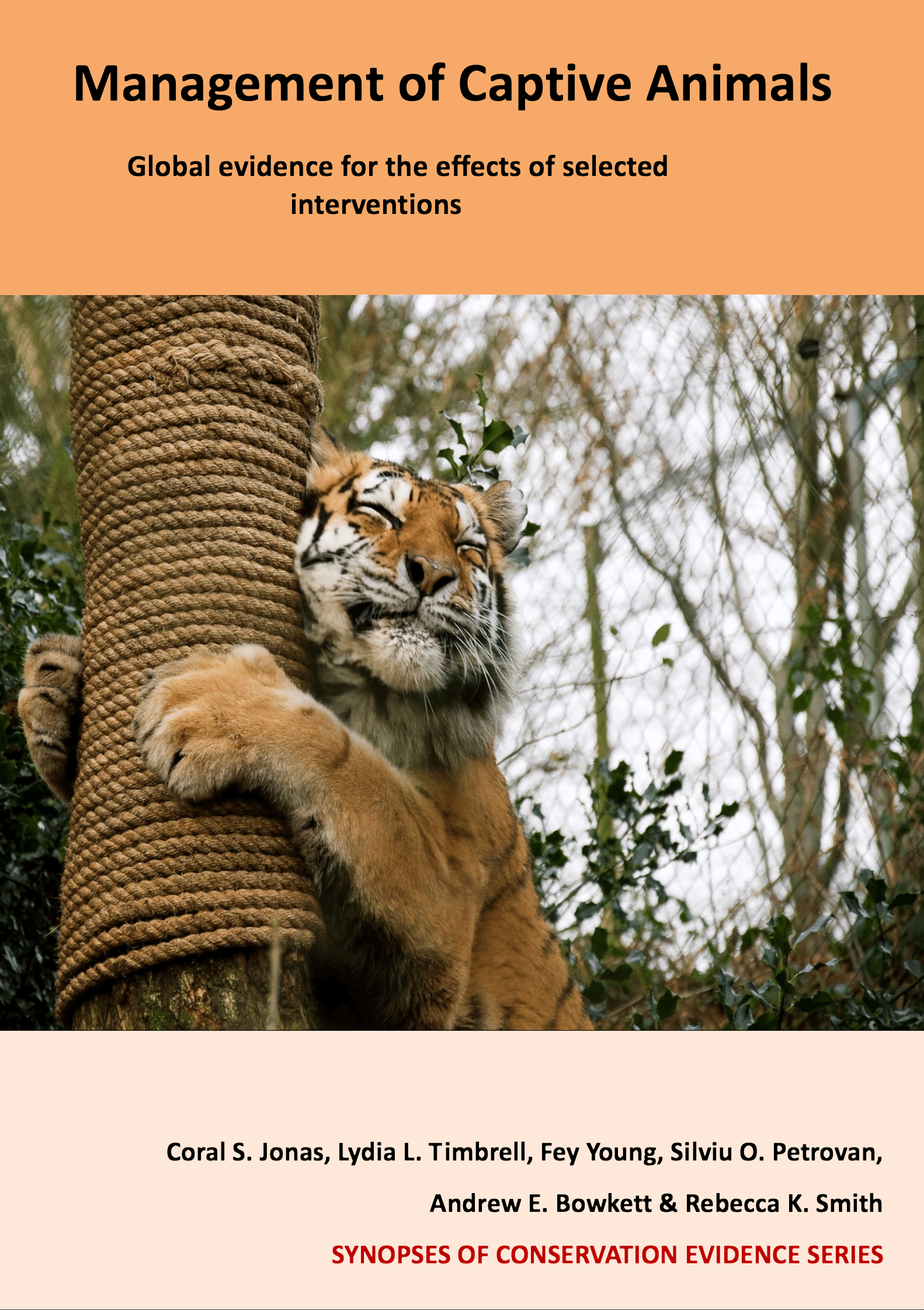Actions to conserve biodiversity
We have summarised evidence from the scientific literature about the effects of actions to conserve wildlife and ecosystems.
Review the evidence from the studies
Not sure what Actions are? Read a brief description.
96 Actions found
Refine
Hide
96 Actions found
Download Actions
Order results by:
| Action | Effectiveness | Studies | Category | |
|---|---|---|---|---|
Amphibians: Use hormone treatment to induce sperm and egg release Action Link | Trade-off between benefit and harms | 17 | ||
Amphibians: Freeze sperm or eggs for future use Action Link | Unlikely to be beneficial | 10 | ||
Carnivores: Provide food on a random temporal schedule Action Link | Trade-off between benefit and harms | 7 | ||
Carnivores: Feed whole carcasses (with or without organs/gastrointestinal tract) Action Link | Trade-off between benefit and harms | 6 | ||
Carnivores: Hide food around enclosure Action Link | Beneficial | 6 | ||
Carnivores: Feed commercially prepared diets Action Link | Unknown effectiveness (limited evidence) | 5 | ||
Primates: Scatter food throughout enclosure Action Link | Beneficial | 4 | ||
Amphibians: Manipulate temperature of enclosure to improve development or survival to adulthood Action Link | Trade-off between benefit and harms | 4 | ||
Amphibians: Use artificial fertilization in captive breeding Action Link | Trade-off between benefit and harms | 4 | ||
Carnivores: Provide bones, hides or partial carcasses Action Link | Likely to be beneficial | 4 | ||
Carnivores: Present food frozen in ice Action Link | Likely to be beneficial | 4 | ||
Carnivores: Present food inside objects (e.g. Boomer balls) Action Link | Likely to be beneficial | 4 | ||
Primates: Present food in puzzle feeders Action Link | Trade-off between benefit and harms | 3 | ||
Carnivores: Provide devices to simulate live prey, including sounds, lures, pulleys and bungees Action Link | Trade-off between benefit and harms | 3 | ||
Primates: Hide food in containers (including boxes and bags) Action Link | Likely to be beneficial | 2 | ||
Primates: Present food frozen in ice Action Link | Likely to be beneficial | 2 | ||
Primates: Maximise both horizontal and vertical food presentation locations Action Link | Likely to be beneficial | 2 | ||
Primates: Formulate diet to reflect nutritional composition of wild foods (including removal of domestic fruits) Action Link | Likely to be beneficial | 2 | ||
Primates: Change the number of feeds per day Action Link | Trade-off between benefit and harms | 2 | ||
Primates: Feed individuals in social groups Action Link | Trade-off between benefit and harms | 2 | ||
Amphibians: Identify and breed a similar species to refine husbandry techniques prior to working with target species Action Link | Unknown effectiveness (limited evidence) | 2 | ||
Amphibians: Vary enclosure temperature to simulate seasonal changes in the wild Action Link | Unknown effectiveness (limited evidence) | 2 | ||
Amphibians: Vary artificial rainfall to simulate seasonal changes in the wild Action Link | Unknown effectiveness (limited evidence) | 2 | ||
Amphibians: Provide multiple egg laying sites within an enclosure Action Link | Unknown effectiveness (limited evidence) | 2 | ||
Amphibians: Provide natural substrate for species which do not breed in water (e.g. burrowing/tunnel breeders) Action Link | Unknown effectiveness (limited evidence) | 2 |
Download Actions

Management of Captive Animals - Published 2018
Captive Animal Synopsis
Watch this search
If you are familiar with RSS feeds, please click the button below to retrieve the feed URL:
RSS feed for this searchIf you are unfamiliar with RSS feeds, we would suggest reading this BBC article.
Unfortunately, due to the number of feeds we have available, we cannot provide e-mail updates. However, you could use tools such as Feed My Inbox to do this for you.
What are 'Individual studies' and 'Actions'?
Individual studies
An individual study is a summary of a specific scientific study, usually taken from a scientific journal, but also from other resources such as reports. It tells you the background context, the action(s) taken and their consequences.
If you want more detail please look at the original reference.
Actions
Each action page focuses on a particular action you could take to benefit wildlife or ecosystems.
It contains brief (150-200 word) descriptions of relevant studies (context, action(s) taken and their consequences) and one or more key messages.
Key messages show the extent and main conclusions of the available evidence. Using links within key messages, you can look at the paragraphs describing each study to get more detail. Each paragraph allows you to assess the quality of the evidence and how relevant it is to your situation.
Where we found no evidence, we have been unable to assess whether or not an intervention is effective or has any harmful impacts.




















